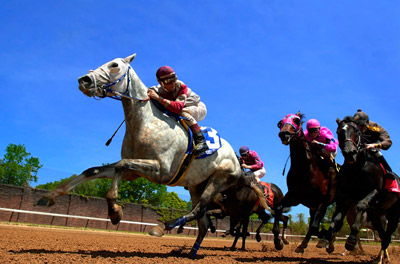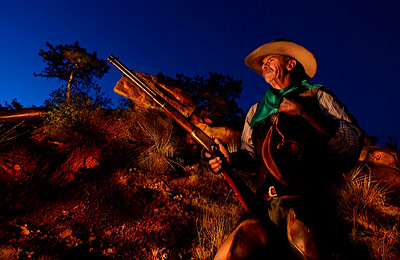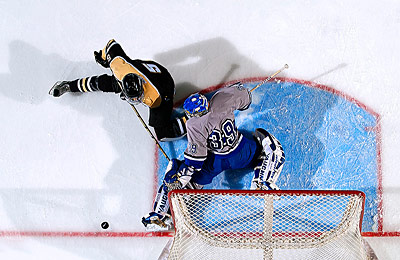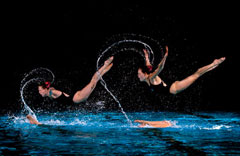 Hi, and welcome to the August edition of Workshop at the Ranch. This month I thought we would take a look at a very useful piece of equipment that makes taking great images possible. Let’s talk about wireless remotes, for cameras and strobes. And the piece of equipment that makes remote work easy for me is the Pocket Wizzard Multi Max transceiver. These units are distributed by Mamiya (I would like to thank Lorenzo Gasperini of Mamiya and his expertise with regards to this product and his efforts with many workshops including Rich Clarksons Sports Photography Workshops) and can be purchased through most camera and photography stores (I purchase my equipment from Jodi Grober at Roberts Distributors of Indianapolis 800-726-5544) These units are compact and reliable.
Hi, and welcome to the August edition of Workshop at the Ranch. This month I thought we would take a look at a very useful piece of equipment that makes taking great images possible. Let’s talk about wireless remotes, for cameras and strobes. And the piece of equipment that makes remote work easy for me is the Pocket Wizzard Multi Max transceiver. These units are distributed by Mamiya (I would like to thank Lorenzo Gasperini of Mamiya and his expertise with regards to this product and his efforts with many workshops including Rich Clarksons Sports Photography Workshops) and can be purchased through most camera and photography stores (I purchase my equipment from Jodi Grober at Roberts Distributors of Indianapolis 800-726-5544) These units are compact and reliable.
Hi, and welcome to the August edition of Workshop at the Ranch. This month I thought we would take a look at a very useful piece of equipment that makes taking great images possible. Let’s talk about wireless remotes, for cameras and strobes. And the piece of equipment that makes remote work easy for me is the Pocket Wizzard Multi Max transceiver. These units are distributed by Mamiya (I would like to thank Lorenzo Gasperini of Mamiya and his expertise with regards to this product and his efforts with many workshops including Rich Clarksons Sports Photography Workshops) and can be purchased through most camera and photography stores (I purchase my equipment from Jodi Grober at Roberts Distributors of Indianapolis 800-726-5544) These units are compact and reliable.
I have been using a Pocket Wizzard system to remotely fire strobes and cameras for over 10 years. Let’s take a look at what the Pocket Wizzard Multi Max transceiver can do for you.
|
The Remote Camera is often used to capture an image from a location not accessible to the photographer during the competition. Horse Racing can be photographed from under the rail at ground level but must be done remotely. The Pocket Wizzard Multi Max is both a transmitter and a receiver at the flick of a switch. I pre set the focus (zone focus ) to capture my subjects at a location on the track. With my NIKON D1X connected to a Muti Max set on Receiver Mode and a specified channel, I can fire the camera with a second Multi Max set on Transmitter Mode by pressing the firing button or by attaching the Multi Max to a hand held camera hotshoe. When attached to the hotshot of my handheld camera I can capture the same subjects from two different angles simultaniously |
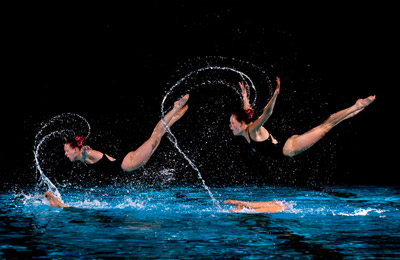 Using Pocket Wizzard Multi Max’s to fire strobes is easy, reliable and of course, wireless. Strobes for sports photography are usually located in the catwalks high above the competition floor, or in this case,the swimming pool. Using Pocket Wizzard Multi Max’s to fire strobes is easy, reliable and of course, wireless. Strobes for sports photography are usually located in the catwalks high above the competition floor, or in this case,the swimming pool. The Multi Max is used as the wireless means to fire the strobes while capturing an image without having ” hard wire ” to connect the strobe packs. Each strobe pack will need to have a Pocket Wizzard Multi Max connected and set in the receiver mode and set on the same channel. The Multi Max set in transmitter mode and set on the same channel as the receivers will fire the strobes at the exact moment the shutter is released. There are no wires between you and the strobes or between the strobes themselves. The system is wireless. |
|
Here is an example of a remote fired wireless for a Lightpainting. With the Multi Max connected to the hot shoe of the camera and the 10 pin connection on my D1X which is of course on a tripod for Lightpainting, I carry the transmitter in my hand, and walk into the location I want to Lightpaint from and fire the camera wireless to capture this image. |
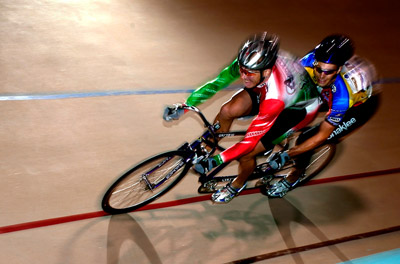 This image clearly required wireless firing of strobes as the Velodrome cycling track was between myself and the strobe. This image clearly required wireless firing of strobes as the Velodrome cycling track was between myself and the strobe. Hard wires could not be routed to the strobes but the Multi Max’s worked perfectly to fire 2 strobes that were located off camera. |
|
Here is an example of Pocket Wizzard Multi Max’s used to fire both the remote camera located over the ice rink and the strobes. I was shooting from the opposite end of the rink but was able to capture great quality and stop the action with my Elinchome 1000R strobes and have a unique ” overhead ” view with my Nikon D1X located over the goal. Both fired remotely with the Pocket Wizzard Multi Max. |
 This bull rider was photographed with a hand held Nikon D1X and a 70mm-200mmVR Zoom lens. This bull rider was photographed with a hand held Nikon D1X and a 70mm-200mmVR Zoom lens. My Elinchome strobes were fired remotely with the Pocket Wizzard Multi Max transceiver on the hotshoe of my camera, connected to the 10 pin port on the D1X and set in transmit mode. The strobes each had a Multi Max set on receiver mode and connected to each strobe unit. Bull riders try to stay on for an 8 second ride, but many rides only last 1 or 2 seconds. The strobes require a recycle time of 1 second (recycle times vary depending on the make and manufacturer, the 1000R units recycle in aprox:1second to reach 3/4 power). This means I might only get 1 image on a rider if he is thrown early. So, I used 2 sets of 4 strobes (8stobes total)….and had a Pocket Wizzard Multi Max for each strobe. I set the Mulit Max on the camera to the Speed Cycle mode and set the Multi Max’s on the first set of strobes to channel A16…. while the second set of strobes had Multi Max’s set to receive in channel B16. With my Multi Max on my camera set on speed cycle and transmit the sets fired in a alternating fashion so that I could shoot a frame every 1/2 second. This is a great feature of the Multi Max transceivers and allowed me 4 frames in a 2 second ride of which there were many that night. |
Well, here are just a few examples as to the advantages of going wireless with the Pocket Wizzard systems. Keep in mind this article is not intended to be an instructional book for the Multi Max units. I do hope it conveys some of the many possibilities that going wireless for remote cameras and strobes can do for the photographer. Q’s and A’s are always welcome. I will be on assignment most of August so please be patient with me when it comes to answering your emails. Until next time with Workshop at the Ranch…………………….Adios, Dave
See you next month, Dave
![]() Hi, and welcome to the August edition of Workshop at the Ranch. This month I thought we would take a look at a very useful piece of equipment that makes taking great images possible. Let’s talk about wireless remotes, for cameras and strobes. And the piece of equipment that makes remote work easy for me is the Pocket Wizzard Multi Max transceiver. These units are distributed by Mamiya (I would like to thank Lorenzo Gasperini of Mamiya and his expertise with regards to this product and his efforts with many workshops including Rich Clarksons Sports Photography Workshops) and can be purchased through most camera and photography stores (I purchase my equipment from Jodi Grober at Roberts Distributors of Indianapolis 800-726-5544) These units are compact and reliable.
Hi, and welcome to the August edition of Workshop at the Ranch. This month I thought we would take a look at a very useful piece of equipment that makes taking great images possible. Let’s talk about wireless remotes, for cameras and strobes. And the piece of equipment that makes remote work easy for me is the Pocket Wizzard Multi Max transceiver. These units are distributed by Mamiya (I would like to thank Lorenzo Gasperini of Mamiya and his expertise with regards to this product and his efforts with many workshops including Rich Clarksons Sports Photography Workshops) and can be purchased through most camera and photography stores (I purchase my equipment from Jodi Grober at Roberts Distributors of Indianapolis 800-726-5544) These units are compact and reliable. 

